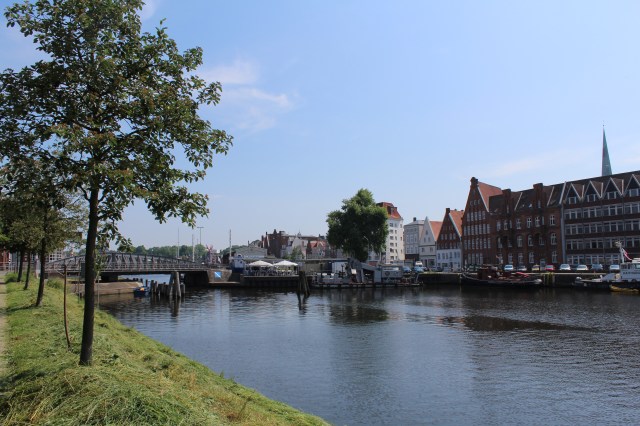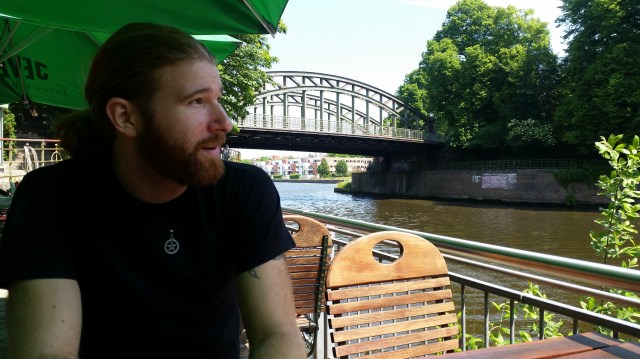Move over, Lüneburg – I’ve got a new favorite medieval city in northern Germany, and it goes by the name of Lübeck.

Like Lüneburg, Lübeck is a picturesque, old-fashioned small town that was once the capital of the Hanseatic League. Both are full of sagging, 500-year-old brick buildings lining curvy cobblestone streets. Both are a short train ride away from Hamburg and make an excellent day trip if you’re staying in Hamburg.I went to Lübeck with my friend Anthony, an American who I knew from undergrad who was doing a major trip throughout Germany. We spent a couple of days wandering around Hamburg, doing some sightseeing and trying to outrun the intermittent rain, then (wisely) on the sunniest day of the week decided to make a day trip to a nearby town. I tried to talk him in to Lüneburg, but his Lonely Planet guidebook couldn’t say enough good things about Lübeck, so we went there instead. I’m glad we did!

With its strategic location, it’s easy to see why Lübeck was such an important trade city. Located at a natural bend in the river Trave, centuries ago locals dug out a canal on the other side so that the city was essentially located on an island. The river flows into the Baltic Sea, from which ships had easy access to important destinations in Scandinavia and eastern Europe. The natural protection of the river that forms a moat around the city, plus the construction of two city walls (neither of which exist today) made Lübeck easy to defend. Coincidentally, this also makes it extremely convenient as a tourist to visit. The core of the city, the historic Altstadt, is all located on one small island that is easy to walk around and navigate. As the city grew, it expanded in all directions away from the island; however, the historic center is highly concentrated and easy to explore in a day.
Our first stop after arriving in Lübeck was actually an accident. We left the main road before even reaching the Altstadt and went for a walk around the river, where we discovered a small hippie compound or squat. There were wagons, converted containers, and AntiFa/No Nazi stickers laying around. Somewhere nearby, somebody was playing a steel drum. This certainly wasn’t in the guide books, but it was fun to stumble across.
Lübeck is a church lover’s paradise. Known as the City of Seven Spires, it has six cathedrals located in the historic center alone, all within short walking distance of each other. The Marienkirche, or St. Mary’s, is the largest church in the city and has twin towers. Its imposing Gothic architecture and brickwork as made it a symbol of the city. It was the first church we visited.

 Initially disappointed to find out that St. Mary’s charged an entrance fee, we stopped complaining when we realized it was only €2. Its high ceiling and understated architecture was very imposing, and made you feel quite small and insignificant as you walked around. The scattered artwork and sculptures did little to fill the daunting empty space.
Initially disappointed to find out that St. Mary’s charged an entrance fee, we stopped complaining when we realized it was only €2. Its high ceiling and understated architecture was very imposing, and made you feel quite small and insignificant as you walked around. The scattered artwork and sculptures did little to fill the daunting empty space.
My favorite part of this church was stumbling upon a memorial for Dietrich Buxtehude, an influential early composer and organist whose works influenced the likes of Handel, Telemann and Bach. I took a few years of organ lessons in high school and college and had learned to play a Buxtehude piece or two, plus visited the Hamburg suburb named after the composer during a study-away organ tour in 2012.
My favorite church that we visited was the Lübeck Cathedral, which, as Lübeck’s oldest church, had existed in some form or other since the year 1173.

When we decided to stop for lunch, we got incredibly lucky and stumbled upon a beautiful, cozy cafe right on the banks of the Trave – Sachers. In addition to having delicious, affordable food and a friendly serving staff, this little gem even had free public restrooms and free Wi-Fi – two things almost unheard of in Germany.

We continued our walk and stumbled on some beautiful ponds.
We visited the Museum Holstentor.
We took a break and had some Eiskaffee.
 Although the name means “iced coffee,” this delectable summertime treat is actually ice cream and coffee, presented like a fancy milkshake or ice cream sundae. Incredibly simple and delicious, in its most basic form it involves a glass of cold coffee with a generous helping of vanilla ice cream on top, similar to a root beer float. The sweet, creaminess of the ice cream perfectly counters the bitterness of the coffee, and the sweet treat is often dressed up with whipped cream, chocolate sprinkles and whole coffee beans on top. My high school German teacher introduced me to Eiskaffee during a high school exchange program to Germany. That was seven years ago, and I still can’t believe Starbucks isn’t serving it yet.
Although the name means “iced coffee,” this delectable summertime treat is actually ice cream and coffee, presented like a fancy milkshake or ice cream sundae. Incredibly simple and delicious, in its most basic form it involves a glass of cold coffee with a generous helping of vanilla ice cream on top, similar to a root beer float. The sweet, creaminess of the ice cream perfectly counters the bitterness of the coffee, and the sweet treat is often dressed up with whipped cream, chocolate sprinkles and whole coffee beans on top. My high school German teacher introduced me to Eiskaffee during a high school exchange program to Germany. That was seven years ago, and I still can’t believe Starbucks isn’t serving it yet.
Our last stop of the day was a local brewery that turned out to be one of the best decisions we had made. Anthony, a true Pacific Northwest craft beer connoisseur, had been getting tired of the watery and flavorless ales typical of north Germany. He had tried drinking local, but after continuous disappointment, gave up and went in search of an Irish pub. Well, the Irish pub was closed when we got there, but another bar a local friend had recommended to me was just around the corner, so we went there instead. And man, did we get lucky.
The bar turned out to be a small brewery that served exactly one type of beer: Brauberger Zwickelbier, the kind they brewed there. The entire menu consisted of this one beer in different sizes, also available as a Radler (mixed with Sprite) or a Diesel (mixed with cola). The beer garden out back was quite full, so we sat at a table next to two older men who turned out to be locals. Little did we know we had hit happy hour, where a .4-liter glass (just under a pint) cost €2. Our new friends knew this and were determined to get their money’s worth. In the hour we were there, they slammed beer after beer – I think they must have had six apiece. As tends to happen when beer is involved, these people we had just met became good friends, and with every beer their broken English and Anthony’s broken German became easier for the other to understand. They told us that the beer we were drinking didn’t actually follow the German beer purity laws, so technically it was being sold as “medicine,” not beer. “I only drink it to stay healthy!” announced one of the men, and he roared with laughter.
They shared their insights into German culture and politics with us, telling us that refugees were okay but they would need to go back at some point, what it was like living in Lübeck, and a common German saying: “Sieben Bier ist auch eine Mahlzeit.” Seven beers counts as a meal!

Anthony had an overnight bus to catch to Munich that night, so we had to cut our conversation short to go catch our train. We rushed to the train station – Anthony power-walking, me walk-skip-running to keep up – only to get there five minutes early and have to wait. We picked up Anthony’s bag from a locker, nearly got cheated out of €24 by a traveler from India who supposedly needed to buy a train ticket, and said our rushed goodbyes.
Lübeck is an easy day trip from Hamburg, has loads of historic sightseeing opportunities and as a tourist is easy to navigate. I would definitely recommend visiting either Lübeck or Lüneburg if you’re traveling to Hamburg, but unless you’ve got an above-average interest in medieval architecture and historic trade routes, probably not both. If I had to choose, I would say Lübeck wins out with its riverside walks and impressive cathedrals, though you can’t really go wrong with either.
One thing that struck me about both cities is how heavily they rely on their former glory. In both cities, part of why the historic buildings are so well preserved is because they haven’t got money to tear them down and build new ones. Lüneburg, once rich off the salt trade and home to an extensive silver collection, has now sold its silver and is struggling with the decision to continue patching up the unstable, sagging brick houses or to tear them down and start anew. Lübeck, former trade capital of the north, is trying to raise money to restore its cathedrals to their former glory and is struggling to attract more tourists to boost its lagging economy. Both are competing with the tourism draw and brain drain of nearby Hamburg, and try to keep visitors enthralled with their historic treasures while distracting from their modern struggles.

Yes, Germany as a country is extremely wealthy, but much of that wealth is concentrated in the south from the tourists enchanted by the castles of the late kingdom of Bavaria and promises of outrageous portions of beer and beautiful women in checkered dresses at Oktoberfest. Many small towns overall still struggle economically, and although it’s been 27 years since the reunification of East and West Germany, economic growth in the eastern states still lags behind under its legacy of socialism. While it was exciting to visit such a historic city and imagine what it would have been like to live in the Middle Ages, it was also a little sad to realize that for many historic cities, their glory days are indeed behind.

























A nice article about your visit to Lübeck. Have you also tried marzipan?
Actually no! We read about the famous marzipan shop, Niederegger, but since neither of us is a big fan of the stuff we decided to skip it. Next time perhaps!